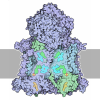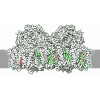[English] 日本語
 Yorodumi
Yorodumi- PDB-8yhq: Cryo-EM structure of Saccharomyces cerevisiae bc1 complex in pyra... -
+ Open data
Open data
- Basic information
Basic information
| Entry | Database: PDB / ID: 8yhq | ||||||
|---|---|---|---|---|---|---|---|
| Title | Cryo-EM structure of Saccharomyces cerevisiae bc1 complex in pyraclostrobin-bound state | ||||||
 Components Components |
| ||||||
 Keywords Keywords | MEMBRANE PROTEIN / Complex / mitochondria / ELECTRON TRANSPORT | ||||||
| Function / homology |  Function and homology information Function and homology information: / Respiratory electron transport / mitochondrial respiratory chain complex III assembly / cellular respiration / respiratory chain complex III / quinol-cytochrome-c reductase / quinol-cytochrome-c reductase activity / mitochondrial electron transport, ubiquinol to cytochrome c / proton transmembrane transport / aerobic respiration ...: / Respiratory electron transport / mitochondrial respiratory chain complex III assembly / cellular respiration / respiratory chain complex III / quinol-cytochrome-c reductase / quinol-cytochrome-c reductase activity / mitochondrial electron transport, ubiquinol to cytochrome c / proton transmembrane transport / aerobic respiration / electron transfer activity / mitochondrial inner membrane / heme binding / mitochondrion / metal ion binding Similarity search - Function | ||||||
| Biological species |  | ||||||
| Method | ELECTRON MICROSCOPY / single particle reconstruction / cryo EM / Resolution: 2.42 Å | ||||||
 Authors Authors | Ye, Y. / Li, Z.W. / Yang, G.F. | ||||||
| Funding support |  China, 1items China, 1items
| ||||||
 Citation Citation |  Journal: J Am Chem Soc / Year: 2024 Journal: J Am Chem Soc / Year: 2024Title: Cryo-EM Structures Reveal the Unique Binding Modes of Metyltetraprole in Yeast and Porcine Cytochrome Complex Enabling Rational Design of Inhibitors. Authors: Yu-Xia Wang / Ying Ye / Zhi-Wen Li / Guang-Rui Cui / Xing-Xing Shi / Ying Dong / Jia-Jia Jiang / Jia-Yue Sun / Ze-Wei Guan / Nan Zhang / Qiong-You Wu / Fan Wang / Xiao-Lei Zhu / Guang-Fu Yang /  Abstract: Cytochrome (complex III) represents a significant target for the discovery of both drugs and fungicides. Metyltetraprole (MET) is commonly classified as a quinone site inhibitor (QI) that combats ...Cytochrome (complex III) represents a significant target for the discovery of both drugs and fungicides. Metyltetraprole (MET) is commonly classified as a quinone site inhibitor (QI) that combats the G143A mutated isolate, which confers high resistance to strobilurin fungicides such as pyraclostrobin (PYR). The binding mode and antiresistance mechanism of MET remain unclear. Here, we determined the high-resolution structures of inhibitor-bound complex III (MET, 2.52 Å; PYR, 2.42 Å) and inhibitor-bound porcine complex III (MET, 2.53 Å; PYR, 2,37 Å) by cryo-electron microscopy. The distinct binding modes of MET and PYR were observed for the first time. Notably, the MET exhibited different binding modes in the two species. In , the binding site of MET was the same as PYR, serving as a -type inhibitor of the Q site. However, in porcine, MET acted as a dual-target inhibitor of both Q and Q. Based on the structural insights, a novel inhibitor (YF23694) was discovered and demonstrated excellent fungicidal activity against downy mildew and powdery mildew fungi. This work provides a new starting point for the design of the next generation of inhibitors to overcome the resistance. | ||||||
| History |
|
- Structure visualization
Structure visualization
| Structure viewer | Molecule:  Molmil Molmil Jmol/JSmol Jmol/JSmol |
|---|
- Downloads & links
Downloads & links
- Download
Download
| PDBx/mmCIF format |  8yhq.cif.gz 8yhq.cif.gz | 727.2 KB | Display |  PDBx/mmCIF format PDBx/mmCIF format |
|---|---|---|---|---|
| PDB format |  pdb8yhq.ent.gz pdb8yhq.ent.gz | Display |  PDB format PDB format | |
| PDBx/mmJSON format |  8yhq.json.gz 8yhq.json.gz | Tree view |  PDBx/mmJSON format PDBx/mmJSON format | |
| Others |  Other downloads Other downloads |
-Validation report
| Summary document |  8yhq_validation.pdf.gz 8yhq_validation.pdf.gz | 2.4 MB | Display |  wwPDB validaton report wwPDB validaton report |
|---|---|---|---|---|
| Full document |  8yhq_full_validation.pdf.gz 8yhq_full_validation.pdf.gz | 2.5 MB | Display | |
| Data in XML |  8yhq_validation.xml.gz 8yhq_validation.xml.gz | 119.9 KB | Display | |
| Data in CIF |  8yhq_validation.cif.gz 8yhq_validation.cif.gz | 178.9 KB | Display | |
| Arichive directory |  https://data.pdbj.org/pub/pdb/validation_reports/yh/8yhq https://data.pdbj.org/pub/pdb/validation_reports/yh/8yhq ftp://data.pdbj.org/pub/pdb/validation_reports/yh/8yhq ftp://data.pdbj.org/pub/pdb/validation_reports/yh/8yhq | HTTPS FTP |
-Related structure data
| Related structure data |  39291MC  8yinC  8zmtC 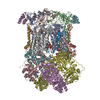 8zosC  8zowC  8zp0C M: map data used to model this data C: citing same article ( |
|---|---|
| Similar structure data | Similarity search - Function & homology  F&H Search F&H Search |
- Links
Links
- Assembly
Assembly
| Deposited unit | 
|
|---|---|
| 1 |
|
- Components
Components
-Protein , 4 types, 8 molecules AJCLDMFO
| #1: Protein | Mass: 47459.270 Da / Num. of mol.: 2 / Source method: isolated from a natural source / Source: (natural)  #2: Protein | Mass: 43686.590 Da / Num. of mol.: 2 / Source method: isolated from a natural source / Source: (natural)  #4: Protein | Mass: 27807.395 Da / Num. of mol.: 2 / Source method: isolated from a natural source / Source: (natural)  References: UniProt: A0A5B9RH60, quinol-cytochrome-c reductase #6: Protein | Mass: 8983.905 Da / Num. of mol.: 2 / Source method: isolated from a natural source / Source: (natural)  |
|---|
-Cytochrome b-c1 complex subunit ... , 6 types, 12 molecules BKENGPHQIRST
| #3: Protein | Mass: 38751.918 Da / Num. of mol.: 2 / Source method: isolated from a natural source / Source: (natural)  #5: Protein | Mass: 20122.955 Da / Num. of mol.: 2 / Source method: isolated from a natural source / Source: (natural)  References: UniProt: A0A8H8ULJ0, quinol-cytochrome-c reductase #7: Protein | Mass: 14452.557 Da / Num. of mol.: 2 / Source method: isolated from a natural source / Source: (natural)  #8: Protein | Mass: 10856.314 Da / Num. of mol.: 2 / Source method: isolated from a natural source / Source: (natural)  #9: Protein | Mass: 6301.232 Da / Num. of mol.: 2 / Source method: isolated from a natural source Details: The sequence of organism Saccharomyces cerevisiae is not available, replaced by P22289 temporarily. Source: (natural)  #10: Protein | Mass: 5879.958 Da / Num. of mol.: 2 / Source method: isolated from a natural source Details: The sequence of organism Saccharomyces cerevisiae is not available, replaced by 559292 temporarily. Source: (natural)  |
|---|
-Non-polymers , 9 types, 20 molecules 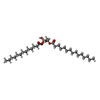
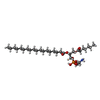
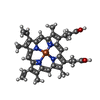

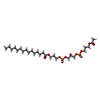


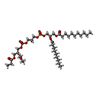







| #11: Chemical | | #12: Chemical | #13: Chemical | ChemComp-HEM / #14: Chemical | #15: Chemical | ChemComp-CN5 / ( | #16: Chemical | #17: Chemical | Mass: 387.817 Da / Num. of mol.: 2 / Source method: obtained synthetically / Formula: C19H18ClN3O4 / Feature type: SUBJECT OF INVESTIGATION #18: Chemical | #19: Chemical | ChemComp-CN3 / ( | |
|---|
-Details
| Has ligand of interest | Y |
|---|---|
| Has protein modification | Y |
-Experimental details
-Experiment
| Experiment | Method: ELECTRON MICROSCOPY |
|---|---|
| EM experiment | Aggregation state: PARTICLE / 3D reconstruction method: single particle reconstruction |
- Sample preparation
Sample preparation
| Component | Name: Saccharomyces cerevisiae bc1 complex / Type: COMPLEX / Entity ID: #1, #3, #2, #4-#9 / Source: NATURAL |
|---|---|
| Source (natural) | Organism:  |
| Buffer solution | pH: 7.4 / Details: PBS,0.1%DDM |
| Specimen | Conc.: 0.5 mg/ml / Embedding applied: NO / Shadowing applied: NO / Staining applied: NO / Vitrification applied: YES |
| Specimen support | Grid type: Quantifoil R1.2/1.3 |
| Vitrification | Cryogen name: ETHANE |
- Electron microscopy imaging
Electron microscopy imaging
| Experimental equipment |  Model: Titan Krios / Image courtesy: FEI Company |
|---|---|
| Microscopy | Model: FEI TITAN KRIOS |
| Electron gun | Electron source:  FIELD EMISSION GUN / Accelerating voltage: 300 kV / Illumination mode: FLOOD BEAM FIELD EMISSION GUN / Accelerating voltage: 300 kV / Illumination mode: FLOOD BEAM |
| Electron lens | Mode: BRIGHT FIELD / Nominal defocus max: 2500 nm / Nominal defocus min: 1200 nm / Alignment procedure: COMA FREE |
| Specimen holder | Cryogen: NITROGEN |
| Image recording | Electron dose: 49.04 e/Å2 / Film or detector model: FEI FALCON IV (4k x 4k) / Num. of real images: 1693 |
- Processing
Processing
| EM software |
| ||||||||||||
|---|---|---|---|---|---|---|---|---|---|---|---|---|---|
| CTF correction | Type: PHASE FLIPPING AND AMPLITUDE CORRECTION | ||||||||||||
| Particle selection | Num. of particles selected: 809936 | ||||||||||||
| 3D reconstruction | Resolution: 2.42 Å / Resolution method: FSC 0.143 CUT-OFF / Num. of particles: 495602 / Symmetry type: POINT | ||||||||||||
| Atomic model building | Protocol: AB INITIO MODEL / Space: REAL | ||||||||||||
| Atomic model building | PDB-ID: 6YMX Accession code: 6YMX / Source name: PDB / Type: experimental model |
 Movie
Movie Controller
Controller







 PDBj
PDBj
